Canelo-Chavez Jr: ¡Viva Mexico!
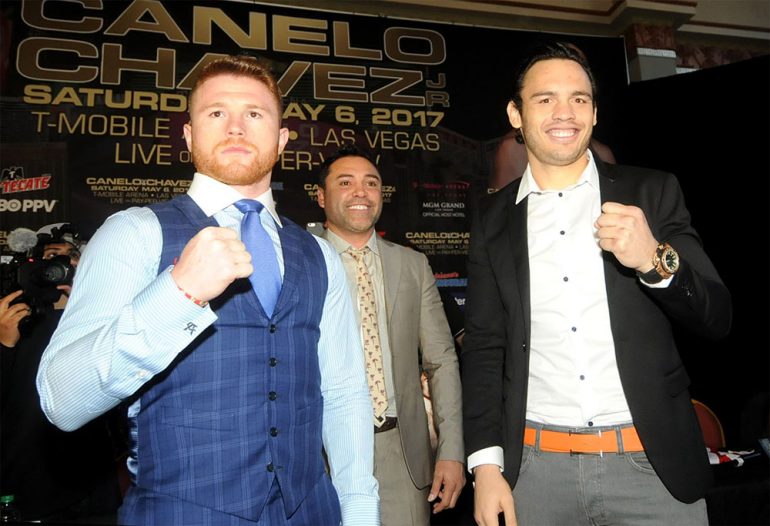
Note: This feature appears in the current issue of THE RING magazine.
Many great Mexican fighters turned to professional boxing in their mid-teens and were grown men way before their time. Unending sacrifice, brutal training regimens, debilitating punishment and searing heat could not quell their passion to become legends from arguably the most boxing-rich country in the world.
Expectations from fans are always high when a Mexican fighter enters a prize ring, higher still when another Mexican fighter is in the opposing corner. This mutual machismo has led to spontaneous combustion in some of the best fights in boxing history. Many of these brutal all-Mexican rivalries remain timeless and some of the stories extend beyond the ropes.
On May 6, Canelo Alvarez and Julio Cesar Chavez Jr. will square off at the T-Mobile Arena in Las Vegas, and the pressure will be on to match the fire and intensity of their predecessors. What follows is a retrospective analysis of five Mexican boxing rivalries that Alvarez and Chavez will hopefully honor when they do battle on Cinco De Mayo weekend.
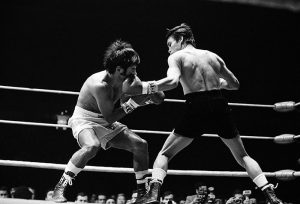
Olivares lands a left on Castillo during the first round of their title bout at the Forum in Los Angeles April 2, 1971.
RUBEN OLIVARES vs. CHUCHO CASTILLO
The rivalry: Three fights (Olivares UD 15; Castillo TKO 14; Olivares UD 15) Years: 1970-71
The Forum in Inglewood, California, played host to an explosive bantamweight trilogy that was completed inside a single year.
On April 18, 1970, undisputed champion Olivares made the second defense of his title against Castillo in a battle for Mexico City. The 23-year-old Olivares was unbeaten in 58 contests and firmly established as one of the finest fighters in the world. But while Castillo lacked Olivares’ finesse and nearly perfect record, he was gutsy and packed a punch. The champion would find that out to his detriment.
After controlling the first two rounds, Olivares was nailed by a counter right hand that put him down briefly in the third. When he rose, but before the referee intervened with the count, Castillo immediately tagged him again with a left hook-right hand combination. The crowd was in an uproar at the rare sight of Olivares being shaken, although the champion responded in style.
Olivares was the superior boxer throughout the remainder of the contest and retained his title by unanimous decision. However, there was enough hype surrounding the first encounter to warrant a rematch.
Six months later the tables turned. Castillo opened a cut around Olivares’ right eye in the opening round and, although the champion boxed brilliantly, the injury got progressively worse as the fight wore on. This time, Olivares was forced into inside exchanges and Castillo held his ground. In the 14th round, with the champion’s face a grotesque crimson mask, referee Dick Young elected to stop the fight.
The public demanded the rubber match and on April 2, 1971, they were treated to a more savage version of the fight. Once again Olivares hit the canvas, this time in Round 6, and once again he responded with the superior ring craft. This time his victory was more dominating and Castillo absorbed fierce body punishment before losing another 15-round unanimous decision.
“It was a terrific rivalry and the whole town was going crazy for them,” recalled former promoter and matchmaker Don Chargin, who was inducted into the International Boxing Hall of Fame in 2001. “Ruben probably had the biggest personality of any fighter I’ve ever seen. He liked the nightlife but he was always a good kid. Castillo was much more reserved and a completely different type of person. He was a good all-around boxer, but Ruben was one of the best bantamweights ever and one of the best body-punchers ever. That was always his equalizer. He had a left hook to the body that paralyzed people.”
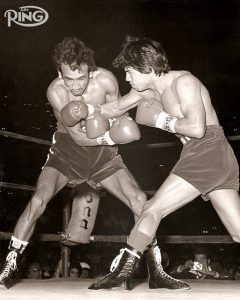
Zamora (right) tags Zarate in a matchup of explosive bantamweight punchers.
CARLOS ZARATE vs. ALFONSO ZAMORA
The rivalry: One fight (Zarate TKO 4) Year: 1977
What didn’t happen in this one? On April 23, 1977, Carlos Zarate, the WBC bantamweight titleholder, and Alfonso Zamora, the RING and WBA bantamweight champion, met up in a 10-round non-title bout at The Forum in Inglewood, California.
Both Mexico City stars were authentic knockout artists. How authentic? Coming in, they had a combined 73 knockouts in 74 fights. This state-of-the-art weaponry, combined with the fact that there was real animosity between both camps, meant that “The Battle of the Z Boys” was hotly anticipated.
In Round 1, the fight was momentarily interrupted in a bizarre scene. A man dressed in his underwear leaped between the ropes and was immediately confronted by police officers. He was immobilized, thrown out of the ring and dragged from the arena as both fighters looked on in amazement.
When the action commenced, Zamora appeared to be the least distracted. He got inside on the much taller Zarate and unloaded a crisp left hook that had an effect. Zarate fired back, however, and took complete control. Firecrackers, lit inside the arena, accompanied the action as Zarate snapped his countryman’s head back repeatedly.
A strong second round was followed by a torrent of punishment in the third and Zamora was finally floored by a right hand. The damage was done. Zarate scored two more knockdowns in the fourth, courtesy of left hooks, which forced Alfonso Zamora Sr. to throw in the towel. Frenzied fans didn’t wait long for an encore. Following the contest, Zamora Sr. stormed the ring and attacked Zarate’s manager, Arturo “Cuyo” Hernandez. Months prior to the contest, Zamora Sr. had bought his son’s managerial contract from Hernandez and a fierce war or words had ensued through the local press. The brawl was broken up by police, who were kept busy that night.
“It was all political,” Chargin said. “Initially Hernandez was going to stay out of the fight and then he went with Zarate. Zamora Sr. took great offense to that and things got out of control. Zarate and Zamora were really good punchers. I once had a fighter called Alberto Sandoval, who was closing in on a title shot. This kid was selling out the Olympic Auditorium, packing the place, and doing really good. I put him in with Zamora and he got flattened. Zamora just couldn’t do anything with Zarate. There was no doubt who the better fighter was.”
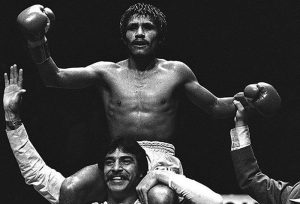
Pintor gets the nod against Zarate by controversial split decision.
CARLOS ZARATE vs. LUPE PINTOR
The rivalry: One fight (Pintor SD 15) Year: 1979
Following the Zamora victory, Zarate defended his belt on five more occasions before challenging Puerto Rican rival Wilfredo Gomez for a junior featherweight title. He lost by fifth-round stoppage and wisely returned to bantamweight.
On June 3, 1979, Zarate made his 10th title defense against Mexico City puncher Lupe Pintor at the Caesars Palace Sports Pavilion in Las Vegas. Pintor, a novice by comparison, was a former stablemate and a huge underdog against the vastly more experienced champion.
The action was nip and tuck over the first three rounds before Zarate unleashed a right lead-left hook combination that floored Pintor. The challenger was up immediately and gamely fought his way back into the contest. Pintor did enjoy success, particularly with the left hook, but Zarate’s work rate and sharpshooting off the back foot appeared to be carrying the day.
Pintor sustained a cut around his right eye and his nose was blooded in the final third of the bout. As the championship rounds progressed, Zarate’s lead seemed to have widened and he had controlled the pace well. It wasn’t enough. At the end of 15 rounds, the first time either man had gone that distance, Pintor was awarded a hotly contested split decision.
Judge Bob Martin gave the fight to Zarate 145-133, but he was overruled by Art Lurie and Harold Buck, who scored 143-142 in favor of the challenger.
The 23-year-old Pintor looked shocked to have been given the verdict and Zarate refused to look his countryman in the eye when the pair came together at ring center. “I thought it was a very close fight,” said Chargin, who would later promote Pintor and acknowledged that he might be “a little prejudiced.”
“It was an important victory for Pintor and he went on to have a great career. We got together at the Hall of Fame last year (when Pintor was inducted) and it was good to see him. That was a great fight with Zarate but, at the time, I honestly thought it was close and both fought very well.”
Pintor developed into a terrific professional. He defended his belt eight times and won a junior featherweight title in 1985. Zarate, a magnificent puncher who was inducted into the Hall of Fame in 1994, was bitterly disappointed by the loss and didn’t fight again for more than six years. He was defeated by Jeff Fenech and Daniel Zaragoza in title fights when he was well past his best.
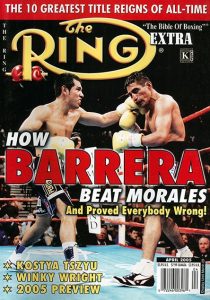 ERIK MORALES vs. MARCO ANTONIO BARRERA
ERIK MORALES vs. MARCO ANTONIO BARRERA
The rivalry: Three fights (Morales SD 12; Barrera UD 12; Barrera MD 12) Years: 2000-04
Legend has it that this rivalry started because of an over-the-top challenge during a soccer game. However, when the action moved to the four corners of a prize ring, Marco Antonio Barrera and Erik Morales electrified the boxing world in a trilogy that spanned four years and three weight divisions.
Their first bout was contested at junior featherweight on February 19, 2000. Both men were titleholders, but the unbeaten Morales was a 4-1 favorite coming in. Those odds were supported by the fact that Barrera had lost twice to Junior Jones, whereas Morales had crushed the American boxer-puncher inside four rounds. That statistic proved to be completely irrelevant.
Ringside seats were only $300 and approximately 7,000 people turned up at the Mandalay Bay Events Center in Las Vegas for one of the greatest fights of all time. A rejuvenated Barrera attacked Morales up and down with brutal combination work and Morales countered with vicious shots of his own. The ebb and flow, the pace and the ferocity of the combat was incredible.
Morales claimed a controversial 12-round split decision and the curtain had risen on one of the most potent rivalries in boxing history. “The wonderful thing was from the first fight through the third fight, these guys hated each other,” said Hall of Fame promoter Bob Arum, who represented Morales on behalf of Top Rank. “There was a tremendous rivalry because Barrera was from Mexico City and Morales was from Tijuana. At the press conference ahead of their second fight Barrera referred to Morales as a dumb Indian and Morales called him a white snob. Suddenly punches started flying, and these guys weren’t f—ing around.”
The rematch took place on June 22, 2002, and while it may not have lived up to their original encounter, it was still an entertaining battle between great fighters. Morales, now a featherweight titleholder, had the edge early, but Barrera upped the pace in the second half to earn himself a questionable 12-round unanimous decision.
The rubber match took place on November 27, 2004. This chapter had shades of the first fight as Barrera let loose from the start. He raked Morales with rapid combinations, damaged his nose with a brutal left uppercut and was the classier operator over 12 enthralling rounds. “The Baby-Faced Assassin” claimed the WBC junior lightweight title via majority decision and emerged victorious in a trilogy for the ages.
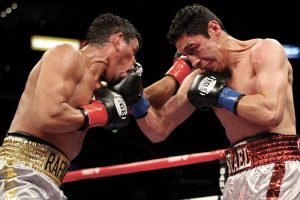
Marquez (left) and Vazquez traded bombs in a classic four-part rivalry.
ISRAEL VAZQUEZ vs. RAFAEL MARQUEZ
The rivalry: Four fights (Marquez TKO 7; Vazquez TKO 6: Vazquez SD 12; Marquez TKO 3) Years: 2007-10
As Barrera and Morales began a slow fade, two worthy successors emerged to continue the tradition of red-hot Mexican rivalries.
On March 3, 2007, Rafael Marquez stepped up from bantamweight to junior featherweight to challenge countryman Israel Vazquez for the RING and WBC titles. Both fighters respected each other immensely, but traded bombs in a classic battle. Marquez went down from a short left hook in the third round but came back to break Vazquez’s nose, an injury which would bring about a seventh-round corner retirement.
Five months later, the rematch raised the bar. Marquez was stunned in another wild third round, but rallied to back up his rival with tremendous flurries. Both men were cut and marked up badly by the sixth round, when Vazquez decked Marquez with a superb left hook. Marquez was unable to recover this time, although many felt that referee Guadalupe Garcia stopped the fight prematurely.
Amazingly, the first two encounters were only a prelude to Vazquez-Marquez III. Vazquez was down in an amazing fourth session and when he got to his feet, his return fire almost floored Marquez seconds later. Both Mexico City stars unloaded everything they had in a stunning fight.
A sizzling three-minute assault by Vazquez in the final round, which culminated in a late knockdown, secured a 12-round split decision in his favor.
“I always feel proud when I think of the trilogy with my fellow Mexican warrior,” said Vazquez of the rivalry that took the careers of both fighters to new heights. “… It was special because few fighters did something like that. I was always excited to fight [Marquez] because we are fighters. I was excited about the possibility of making history every time we fought.”
A fourth bout generated a lot of money but it was a letdown by comparison. Vazquez entered the ring a shell of himself and scar tissue around his eyes was a handicap before a punch was thrown. Gruesome cuts prompted the referee to stop the fight in the third round and the rivalry ended at two wins apiece.
It is often said that fighters leave a piece of themselves in the ring after grueling wars. Within the last year, Vazquez, an amiable and charismatic man, had an operation to remove his right eye in part because of injuries sustained in his final encounter with Marquez. Mexican warrior that he is, he said there are no regrets.
Tom Gray is a UK Correspondent/ Editor for RingTV.com and a member of THE RING ratings panel. Follow him on Twitter: @Tom_Gray_Boxing
Struggling to locate a copy of THE RING Magazine? Try here or…
SUBSCRIBE
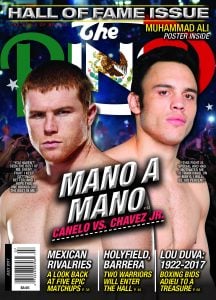
You can subscribe to the print and digital editions of THE RING Magazine by clicking the banner or here. You can also order the current issue, which is on newsstands, or back issues from our subscribe page. On the cover this month: Canelo vs. Chavez Jr. – Mano A Mano.














